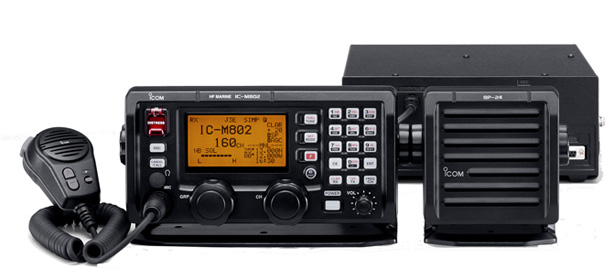
My wife Theresa and I, with only a VHF radio to reach the outside world, fell into the incommunicado category during our cruising days. This is one reason why contributing writer Capt. Frank Lanier, who has been busily testing a wide range of electronics aboard his Union 36, is contributing to this weeks post on the relevance of single-sideband (SSB) transceivers.
As satellite communication equipment becomes more reasonably priced, more reliable, and more compact, we often hear sailors raise the question, Are single-sideband radios even relevant anymore? As Lanier points out, the question is easy to answer: Yes, absolutely. Here is an excerpt from his forthcoming report on single-sideband radios, which also will look at some of the latest products for simplifying SSB installation.
While single-sideband radios have long been a priority aboard any serious cruising vessel, technology has put the squeeze on SSBs reign as the defacto choice for long-range communications in recent years. The challengers are satellite-based communication devices that have stormed the market in recent years (see reviews in PS January 2013 and March 2013 issues). Of these, satellite phones are the primary high-seas communication alternative to SSB transceivers (a fancy word meaning it can both transmit and receive). Satphones have become particularly attractive since the introduction of affordable (or at least more affordable) units and service plans.
As with any apples-to-oranges comparison of two totally different systems providing similar features or services (voice communications, e-mail, etc.), both will invariably have their pros and cons. The trick is weighing each of these to determine which is best for you.
Operationally, the most obvious advantages of satellite phones is their ease of use, a result of our familiarity with cell phones. Other advantages would be the ability to easily call a landline phone number (although this can also be done with SSB using services like ShipCom), as well as easy (or no) installation requirements or costs.
A satellite phones portability is also a bonus over SSB; you can take it with you should you need to abandon ship or simply want to carry it along on shore excursions for non-emergency use.As to satphone cons, the first is the same disadvantage attributed to cell phones when compared to VHF radios. Satphones can’t provide ship-to-ship safety communications or communications with rescue vessels or aircraft.
Also, as is the case with cell phones, if you make a distress call using a satphone, only the party you call will be able to hear you. An SSB radio allows for an unlimited number of people to listen in on a transmission. Other nearby commercial and recreational vessels that may be monitoring the airwaves could lend a hand or communicate directly with you to offer advice, act as relay, etc.
Single sideband is also the only way to participate in various regional safety and cruising nets, such as the BASRA (Bahamas Air and Sea Rescue Association) Weather, Safety, & Traffic Net; Cruiseheimers Traffic Net; or Chris Parkers popular Caribbean Weather Net. Many cruising events, such as the Atlantic Rally for Cruisers Caribbean 1500, require participants to have a single-sideband radio on board, so that they can stay in contact and share important safety and weather bulletins.
Another benefit of having an SSB onboard is the ability to tune into AM and FM bands and shortwave radio stations around the globe, allowing you to receive the latest news, sports, or simply listen to music no matter where you are.
An additional safety benefit is that some SSB models are equipped with Digital Selective Calling (DSC), which is part of the internationally adopted Global Maritime Distress Safety System (GMDSS). All commercial ships mandated to have DSC are required to monitor DSC marine SSB frequencies while at sea. In the event of an emergency, they (or any other HF-, SSB-, DSC-equipped vessel) would receive your exact location (assuming youve provided GPS data to your SSB) and the nature of distress at the push of a button. As with VHF DSC, this effectively takes the search out of search and rescue, allowing rescue agencies (and nearby good Samaritans) to provide immediate assistance, rather than waste valuable time trying to locate you first.
Look for our forthcoming report on single-sideband radios, antennas, tuners, and various auxiliary devices in the September issue of Practical Sailor.







































